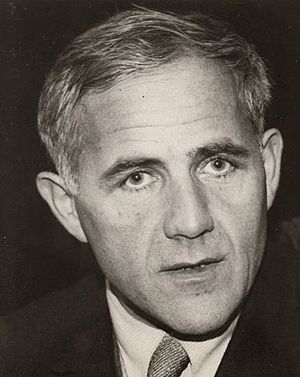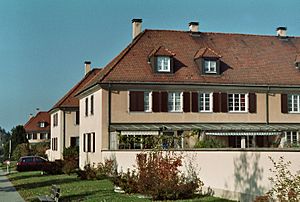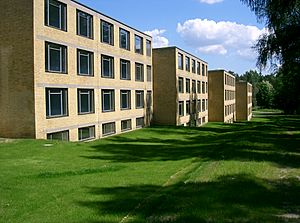Hannes Meyer facts for kids
Quick facts for kids
Hannes Meyer
|
|
|---|---|
 |
|
| Born |
Hans Emil Meyer
18 November 1889 |
| Died | 19 July 1954 (aged 64) |

Hans Emil "Hannes" Meyer was a famous Swiss architect. He was born on November 18, 1889, and passed away on July 19, 1954. He is best known for being the second director of the Bauhaus school in Germany.
Contents
Growing Up and Early Career
Hannes Meyer was born in Basel, Switzerland. He first trained as a mason, which means he learned how to build with stone and brick. Later, he worked as an architect in Switzerland, Belgium, and Germany. For a short time, from 1916 to 1918, he even managed a department at the Krupp factories in Essen.
Designing New Buildings
Between 1919 and 1921, Meyer finished planning a group of homes called "Freidorf" near Basel. In 1923, he helped start an architecture magazine called 'ABC Beiträge zum Bauen' (Contributions on Building). He worked on this with other architects like Hans Schmidt, Mart Stam, and artist El Lissitzky.
In 1926, Meyer started a company with Hans Wittwer. They created two of his most famous designs. These were for the Basel Petersschule and the Geneva League of Nations Building. Both designs were very modern and used new ideas for steel structures. However, neither of these buildings was actually built. The Petersschule was planned as a new primary school for girls. It was designed to be high above the ground to get lots of sunlight and fresh air.
Leading the Bauhaus School
In April 1927, Walter Gropius, the first director of the Bauhaus, asked Meyer to lead the school's architecture department. Meyer believed in a style called functionalism. This meant that buildings should be useful and meet social needs, not just look pretty. He called his ideas Die neue Baulehre (the new way to build).
Meyer brought two very important building projects to the Bauhaus. Both of these buildings still exist today.
Bauhaus Buildings in Dessau
One project was five apartment buildings in Dessau, Germany. They are known as Laubenganghäuser, which means "Houses with Balcony Access". These apartments are seen as true Bauhaus buildings because they were designed by the school's architecture department.
The ADGB Trade Union School
The other major project was the Bundesschule des Allgemeinen Deutschen Gewerkschaftsbundes, also known as the ADGB Trade Union School. This school was built in Bernau bei Berlin and finished in 1930. It was the second largest project ever built by the Bauhaus.
The school was used for only three years. In 1933, it was taken over and used for management training. Today, the building is protected as a historic site. It was carefully restored and finished in 2007. This restoration project even won an award in 2008. In 2017, both the Laubenganghäuser and the ADGB Trade Union School became part of the Bauhaus and its Sites in Weimar, Dessau and Bernau World Heritage Site.
Leaving the Bauhaus
Walter Gropius chose Meyer to take over as the Bauhaus director on April 1, 1928. Meyer continued Gropius's ideas of designing things for mass production and functional architecture. However, the political situation in Germany was becoming difficult. The mayor of Dessau, Hesse, claimed that Meyer allowed a student group with certain political ideas to grow. This caused problems for the school. Because of this, Meyer was dismissed as head of the Bauhaus school on August 1, 1930.
Life After Bauhaus
In the autumn of 1930, Meyer moved to the Soviet Union. Several former Bauhaus students went with him, including Konrad Püschel. He taught at WASI, a Soviet school for architecture. During his time in the Soviet Union, he helped with city planning projects. He also created plans for parts of Moscow as part of a big development plan.
Meyer also worked on projects outside Moscow. He helped develop the city of Birobidzhan in the Jewish Autonomous Oblast. He designed buildings like worker's dorms and a theater, and also planned the city layout.
From 1933 onwards, Meyer faced increasing difficulties with the authorities. He returned to Geneva, Switzerland, in 1936. Sadly, his partner, Margarete Mengel, who was German, could not get a visa and had to stay in Moscow with their son. Margarete was later arrested and passed away in 1938. Their son, Johannes Mengel, survived and only learned about his mother's death much later.
In 1939, Meyer moved to Mexico City. He worked for the Mexican government as the director of the Instituto del Urbanismo y Planificación until 1941. In 1942, he became the director of Estampa Mexicana, a publishing house.
Meyer returned to Switzerland in 1949 and passed away in 1954.
See also
 In Spanish: Hannes Meyer para niños
In Spanish: Hannes Meyer para niños
Images for kids





